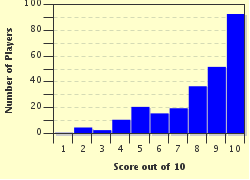Quiz Answer Key and Fun Facts
1. Try as I might, I simply don't understand how brightly-colored rectangles represent art, but this painter of "Composition with Yellow, Blue, and Red" is generally considered one of the most influential of the 20th century, inspiring the De Stijl school. Whatever. To me, it looks like a toddler with only three colored pencils. Who was this Dutch artist of works like "Broadway Boogie Woogie"?
2. Is abstract expressionism really art? I feel fairly certain that I could make little colorful circles on the canvas by standing a few feet away and flicking my brush at it, but nobody pays me the big bucks to do it. Regardless, this famed American created a painting that has sold for 140 million dollars, his "No. 5, 1948." Which "action painting" theorist was responsible?
3. Modern sculpture has gotten so abstract that not even US customs officials can tell the difference between squares, circles, and triangles, and real art. When a certain Romanian sculptor tried to bring his masterpiece "Bird in Space" into the country, it was taxed for the metal, as the customs officials disagreed that the piece of polished bronze actually counted as art. Who was this modern sculptor of works like "The Endless Column" and "Sleeping Muse"?
4. One thing that's always bothered me about the modern artists who just use squares, circles, and triangles is that they can't even be bothered to make them good squares, circles, and triangles. Take Mark Rothko, a Russian-born abstract expressionist. His works consist principally of slightly-wonky rectangles of various colors drawn across the canvas. Which of the following is not a Rothko painting?
5. Hey, I can cut and paste pictures from magazines onto a canvas as well as the next guy, but, somehow, Richard Hamilton's small collage "Just what is it that makes today's homes so different, so appealing" has achieved iconic status. He's not the only one, either. Roy Liechtenstein's comic-book style drawings, Jasper Johns' flags, and, of course, one artist's Factory-produced images of Campbell's soup cans and Marilyn Monroe became major hits in the twentieth century. From which '50s and '60s art movement did they arise?
6. Henri Matisse's painting "The Yellow Curtain" can be essentially reduced down to yellow right triangles and quarter-circles. And, not to get cocky or anything, but I'm pretty sure that I could draw as good of a curtain. Unlike Matisse, though, I didn't create a controversial new genre of painting emphasizing vivid, unrealistic colors, a genre that was derided with the French name for "beasts" after the 1905 Salon d'Atomne. What style did Matisse create?
7. To some people, hanging random objects from rods so that they move in the wind counts as a touristic ploy, not modern art. Yet, inexplicably, Alexander Calder caused a renaissance in the modern sculpture community with his works like "Lobster Trap and Fishtail." What sort of work did Calder develop and call "kinetic sculptures"?
8. Is it "an explosion in a shingle factory"? Or a regular bicycle wheel? How about a picture of the "Mona Lisa" with a mustache drawn on it? Sometimes I wonder whether or not these works were just an elaborate prank contrived by the artist, rather than legitimate art. Who was responsible for such modern works as "Nude Descending a Staircase," "L.H.O.O.Q.," and "Fountain"?
9. Eleven islands in Biscayne Bay, the coast of Little Bay in Australia, the Berlin Reichstag, and Central Park in New York City have played home to a modern art project led by Christo and his wife Jeanne-Claude. Controversial or not, the couple have left their signature works of art around the world. What art form did they use on the aforementioned landscapes?
10. Not only was he an abstract artist, but this Russian defined several dogmas of modern art with his works on art theory, He contended that colors and shapes evoke particular emotions in the viewer. It worked: his expressionism is clearly shown in works like "The Blue Rider." Who was this man, to whom we can probably assign most of the blame for modern art?
Source: Author
adams627
This quiz was reviewed by FunTrivia editor
LadyCaitriona before going online.
Any errors found in FunTrivia content are routinely corrected through our feedback system.

